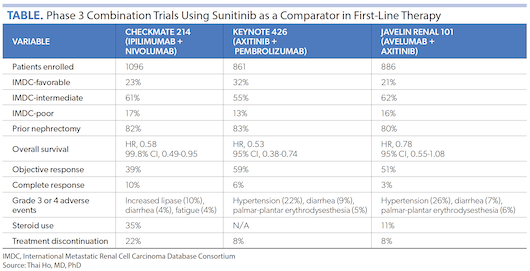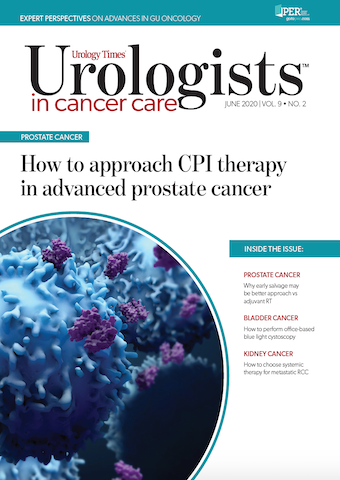Publication
Article
Urology Times Urologists in Cancer Care
How to choose systemic therapy for metastatic RCC
Author(s):
Combination therapy is the first-line standard for metastatic renal cell carcinoma.
Combination therapies have become the standard of care in the treatment of patients with metastatic renal cell carcinoma (RCC). Scientific discoveries culminating in Nobel Prizes that were sequentially awarded in physiology or medicine in 2018 and 2019 have dramatically changed the RCC treatment paradigm from monotherapies to combinations. The 2018 Nobel Prize presented to James Allison, PhD, and Tasuku Honjo, MD, PhD, was awarded for identifying key proteins that act as brakes on the immune system. These discoveries led to the development of immune checkpoint inhibitors (ICIs) (atezolizumab [Tecentriq], avelumab [Bavencio], ipilimumab [Yervoy], nivolumab [Opdivo], and pembrolizumab [Keytruda]).
The 2019 Nobel Prize presented to William Kaelin, MD, Sir Peter Ratcliffe, FRS, and Gregg Semenza, MD, PhD, was awarded for elucidating how cells sense and adapt to low oxygen levels by regulating blood vessel growth. These discoveries led to the development of antiangiogenic therapies (axitinib [Inlyta], bevacizumab [Avastin], cabozantinib [Cabometyx], lenvatinib [Lenvima], pazopanib [Votrient], sorafenib [Nexavar], and sunitinib [Sutent]).
When evaluating clinical studies and ultimately choosing a first-line therapy, it is important to assess: patient prognostic category, efficacy, mechanism of action, safety, and route/schedule of administration. Prognostic scoring systems integrate independent prognostic factors of survival in patients affected by metastatic RCC. The International Metastatic Renal Cell Carcinoma Database Consortium Criteria uses standard laboratory values and clinical assessment to apply risk stratification to categorize patients into favorable-, intermediate-, and poor-risk groups.1 Prognostic factors include less than 1 year from the time of diagnosis to systemic therapy, performance status (<80% Karnofsky Performance Status Scale), hemoglobin below the lower limit of normal (normal lower limit, 12 g/dL), calcium above the upper limit of normal (normal range, 8.5-10.2 mg/dL), neutrophils above the upper limit of normal (normal range, 2.0-7.0 x 109/L), and platelet counts above the upper limit of normal (normal, 150,000-400,000). Favorable-risk groups have no prognostic factors, intermediate-risk groups have 1 or 2 prognostic factors, and poor-risk groups have 3 to 6 prognostic factors.
Prior to 2018, sunitinib antiangiogenic monotherapy was considered the standard of care for first-line treatment of patients with RCC, but durable responses were rare. Cytokine therapies had durable complete responses (CRs) but were limited by their toxicities and were largely reserved for healthy patients.
From 2018 to 2019, 3 combinations (ipilimumab + nivolumab, pembrolizumab + axitinib, avelumab + axitinib) were approved by the FDA for demonstrating improved overall survival in phase 3 trials when compared with sunitinib monotherapy (Table), with improved CRs. The CHECKMATE 214 trial studied the combination of ipilimumab (inhibits cytotoxic T-lymphocyte–associated protein-4) with nivolumab (inhibits PD-1) to restore patients’ immune surveillance mechanisms to target RCC.2 On the other hand, the KEYNOTE-426 and JAVELIN Renal 101 trials studied the combinations of axitinib (inhibits angiogenesis) with pembrolizumab (inhibits PD-1) and axitinib with avelumab (inhibits PD-L1), respectively to simultaneously restore patients’ immune surveillance mechanisms and target angiogenesis.3,4 In all 3 studies, at least 80% of the patients had a prior nephrectomy. As a group, the objective response rates, which include complete and partial responses, range from 39% to 59%.

Historically, single-agent sunitinib had CRs of 1%, whereas the combination regimens range from 3% to 10% with the highest CR rate observed in the CHECKMATE 214 trial further supporting the role of harnessing the immune system to produce durable responses. However, with the higher CR rate, CHECKMATE 214 also had a higher incidence of treatment discontinuation at 22%. Based on the National Comprehensive Cancer Network Guidelines (version 2.2020), ipilimumab + nivolumab and axitinib + pembrolizumab are preferred category 1 recommendations per the International Metastatic Renal Cell Carcinoma Database Consortium for patients with intermediate- or poor-risk disease with clear cell histology.5 Axitinib + pembrolizumab is recommended for favorable-risk patients with clear cell histology.
Although biomarkers such as PD-L1 immunohistochemistry were evaluated in the 3 studies, there is no FDA label requirement for a predictive marker to prescribe any of the 3 combinations. Emerging first-line therapies that are undergoing FDA review include the combination of cabozantinib with nivolumab.
Adverse event profiles
As part of a multidisciplinary team for the treatment of RCC, it is important to consider that each combination has unique adverse event (AE) profiles depending on their mechanism of action. As a class, antiangiogenic small molecules have been associated with hypertension, diarrhea, palmar-plantar erythrodysesthesia, and hypothyroidism. Management typically includes titration of antihypertensives, antidiarrheals (loperamide or diphenoxylate), topical creams (lidocaine, moisturizing exfoliants), and thyroid replacement therapy, respectively. Depending on the half-life of the small molecules and liver metabolism, these antiangiogenic therapies may also impair wound healing and interact with other drugs that are processed through the cytochrome P450 system.
In contrast, immune checkpoint therapies have been associated with autoimmune phenomena or inflammation of the lungs, intestines, skin, liver, and heart requiring inpatient admission for administration of high-dose steroids and may require weeks of a prolonged steroid taper. The increased immune activity related to T-cell activation/proliferation, increased complement-mediated inflammation, and increased cytokine production may affect any healthy tissue. The rate of high-dose steroid administration for ipilimumab + nivolumab was 35%, and for avelumab + axitinib, 11%.
These immune-related AEs typically manifest between 2 to 9 weeks for cytotoxic T-lymphocyte associated protein-4 and 5 to 10 weeks for PD-1/PD-L1 therapies. Allergic-type infusion reactions can occur with monoclonal antibodies and can be managed with premedications. The AEs of immune checkpoint therapies require early identification because they self-propagate, whereas the small-molecule AEs typically resolve after discontinuation. To manage AEs, ICIs are usually held completely, as opposed to the small molecules, which are dose adjusted.
Given the increasing number of biological drug choices, it can be challenging to recall the names or mechanisms of action. In general, cancer drugs that end with the suffix “nib” refer to small molecules and typically have oral administration routes. The suffix “mab” refers to monoclonal antibodies, which are typically administered intravenously (IV). Consistent with using the suffixes as a guide, the ipilimumab + nivolumab ICI combination is administered every 3 weeks IV for 4 cycles and then patients can be transitioned to nivolumab monotherapy IV every 4 weeks. In contrast, axitinib is administered twice a day orally in combination with either pembrolizumab IV every 3 weeks or avelumab IV every 2 weeks.
Conclusions
The discoveries from 2 Nobel Prize groups have advanced the field to combination therapies of ICIs from cytokine-based immunotherapies that were difficult to administer or antiangiogenic inhibitors that lacked durable responses. By targeting multiple pathways in a tumor and its microenvironment, these combination therapies have improved CRs. Future trials are focused on finding new mechanisms to restore the immune system surveillance after prior immune checkpoint failure and targeting transcription factors involved in angiogenesis.
Ho is associate professor in the Division of Hematology/Oncology at Mayo Clinic Arizona, Phoenix.
References
1. Heng DY, Xie W, Regan MM, et al. Prognostic factors for overall survival in patients with metastatic renal cell carcinoma treated with vascular endothelial growth factor-targeted agents: results from a large, multicenter study. J Clin Oncol. 2009;27:5794-5799. doi:10.1200/JCO.2008.21.4809
2. M Motzer RJ, Tannir NM, McDermott DF, et al. Nivolumab plus ipilimumab versus sunitinib in advanced renal-cell carcinoma. N Engl J Med. 2018;378:1277-1290. doi:10.1056/NEJMoa1712126
3. Rini BI, Plimack ER, Stus V, et al. Pembrolizumab plus axitinib versus sunitinib for advanced renal-cell carcinoma. N Engl J Med. 2019;380:1116-1127, doi:10.1056/NEJMoa1816714
4. Motzer RJ, Penkov K, Haanen J, et al. Avelumab plus axitinib versus sunitinib for advanced renal-cell carcinoma. N Engl J Med. 2019;380:1103-1115. doi:10.1056/NEJMoa1816047
5. Motzer RJ, Jonasch E, Michaelson MD, et al. NCCN guidelines insights: kidney cancer, version 2.2020. J Natl Compr Canc Netw 2019. 17:1278-1285, doi:10.6004/jnccn.2019.0054





















